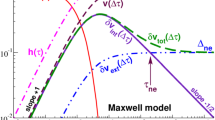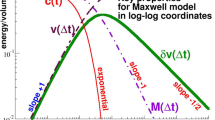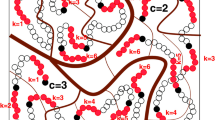Abstract
We investigate the standard deviation \(\delta v(\Delta t)\) of the variance \(v[\mathbf {x}]\) of time series \(\mathbf {x}\) measured over a finite sampling time \(\Delta t\) focusing on non-ergodic systems where independent “configurations” c get trapped in meta-basins of a generalized phase space. It is thus relevant in which order averages over the configurations c and over time series k of a configuration c are performed. Three variances of \(v[\mathbf {x}_{ck}]\) must be distinguished: the total variance \(\delta v^2_{\mathrm {tot}}= \delta v^2_{\mathrm {int}}+ \delta v^2_{\mathrm {ext}}\) and its contributions \(\delta v^2_{\mathrm {int}}\), the typical internal variance within the meta-basins, and \(\delta v^2_{\mathrm {ext}}\), characterizing the dispersion between the different basins. We discuss simplifications for physical systems where the stochastic variable x(t) is due to a density field averaged over a large system volume V. The relations are illustrated for the shear-stress fluctuations in quenched elastic networks and low-temperature glasses formed by polydisperse particles and free-standing polymer films. The different statistics of \(\delta v_{\mathrm {int}}\) and \(\delta v_{\mathrm {ext}}\) are manifested by their different system-size dependences.
Graphic abstract










Similar content being viewed by others
Notes
The term “sampling time” is elsewhere often used for the time-interval \(\delta t\) between neighboring data points.
The response function due to an externally applied “force” conjugated to x switched on at \(t=0\) is given within linear response by h(t) [5].
The time series k may be obtained by first tempering the configuration c over a time interval \({\Delta t}_{\mathrm {temp}}\) larger than the basin relaxation time \(\tau _{\mathrm {b}}\) and by sampling then \(n_\mathrm {k}\) time intervals \(\Delta t\) separated by constant spacer intervals \({\Delta t}_{\mathrm {spac}}\gg \tau _{\mathrm {b}}\).
This assumption also holds for \(\Delta t\gg \tau _{\alpha }\) for a finite terminal relaxation time \(\tau _{\alpha }\) associated with the transitions between the meta-basins. Note that the systems is ergodic in the second regime.
The stochastic process is ergodic within the basin.
The film volume is \(V=L^2H\) with H being the film height determined from the density profile using a Gibbs dividing surface construction [22]. Since the stress tensor vanishes outside the films, the average vertical normal stress must also vanish for all z-planes within the films. The pressure P indicated for the films in Table 1 refers to the normal tangential stresses.
Only the TSANET systems for \(\nu =0\) are rigorously non-ergodic for \({\Delta t}_{\mathrm {max}}\rightarrow \infty \). The film system is in a transient regime with a wide spectrum of relaxation times both below and above \({\Delta t}_{\mathrm {max}}\). As a result Eq. (35) cannot hold exactly. As for the pLJ model, its relaxation time spectrum is apparently well below \({\Delta t}_{\mathrm {max}}\).
The non-Gaussianity parameter \(\alpha _2\) is seen to increase somewhat for smaller system sizes. The typical values are, however, always rather small, e.g., \(\alpha _2 \ll 0.04\) for all times for pLJ particles with \(n=100\).
The stress-fluctuation formalism for \(B_p\) uses the fluctuations of stationary stochastic processes, i.e. no external (linear) perturbation is applied to measure directly the moduli. It is unclear whether the out-of-equilibrium processes are described by the same fluctuations. It is an open theoretical question of how to generalize the fluctuation-dissipation relations, connecting the average linear out-of-equilibrium response to the average equilibrium relaxation [5, 7, 19], for their fluctuations.
References
W. Press, S. Teukolsky, W. Vetterling, B. Flannery, Numerical Recipes in FORTRAN: The Art of Scientific Computing (Cambridge University Press, Cambridge, 1992)
N.G. van Kampen, Stochastic Processes in Physics and Chemistry (North-Holland, Amsterdam, 1992)
T. Pang, An Introduction to Computational Physics, 2nd edn. (Cambridge University Press, Cambridge, 2006)
P.M. Chaikin, T.C. Lubensky, Principles of Condensed Matter Physics (Cambridge University Press, Cambridge, 1995)
M. Doi, S.F. Edwards, The Theory of Polymer Dynamics (Clarendon Press, Oxford, 1986)
M. Rubinstein, R.H. Colby, Polymer Physics (Oxford University Press, Oxford, 2003)
J.P. Hansen, I.R. McDonald, Theory of Simple Liquids, 3rd edn. (Academic Press, New York, 2006)
J.D. Ferry, Viscoelastic Properties of Polymers (Wiley, New York, 1980)
W.W. Graessley, Polymeric Liquids & Networks: Dynamics and Rheology (Garland Science, London, 2008)
E.B. Tadmor, R.E. Miller, R.S. Elliot, Continuum Mechanics and Thermodynamics (Cambridge University Press, Cambridge, 2012)
E.B. Tadmor, R.E. Miller, Modeling Materials (Cambridge University Press, Cambridge, 2011)
M.P. Allen, D.J. Tildesley, Computer Simulation of Liquids, 2nd edn. (Oxford University Press, Oxford, 2017)
D.P. Landau, K. Binder, A Guide to Monte Carlo Simulations in Statistical Physics (Cambridge University Press, Cambridge, 2000)
L. Klochko, J. Baschnagel, J.P. Wittmer, A.N. Semenov, J. Chem. Phys. 151, 054504 (2019)
G. George, L. Klochko, A. Semenov, J. Baschnagel, J.P. Wittmer, EPJE (2021)
A. Heuer, J. Phys. Condens. Matter 20, 373101 (2008)
P. Charbonneau, J. Kurchan, G. Parisi, P. Urbani, F. Zamponi, Nat. Commun. 5, 3725 (2014)
I. Procaccia, C. Rainone, C.A.B.Z. Shor, M. Singh, Phys. Rev. E 93, 063003 (2016)
J.P. Wittmer, I. Kriuchevskyi, A. Cavallo, H. Xu, J. Baschnagel, Phys. Rev. E 93, 062611 (2016)
I. Kriuchevskyi, J.P. Wittmer, H. Meyer, J. Baschnagel, Phys. Rev. Lett. 119, 147802 (2017)
I. Kriuchevskyi, J.P. Wittmer, H. Meyer, O. Benzerara, J. Baschnagel, Phys. Rev. E 97, 012502 (2018)
G. George, I. Kriuchevskyi, H. Meyer, J. Baschnagel, J.P. Wittmer, Phys. Rev. E 98, 062502 (2018)
J.P. Wittmer, H. Xu, P. Polińska, F. Weysser, J. Baschnagel, J. Chem. Phys. 138, 12A533 (2013)
J.L. Lebowitz, J.K. Percus, L. Verlet, Phys. Rev. 153, 250 (1967)
J.P. Wittmer, A. Tanguy, J.L. Barrat, L. Lewis, Europhys. Lett. 57, 423 (2002)
A. Tanguy, J.P. Wittmer, F. Leonforte, J.L. Barrat, Phys. Rev. B 66, 174205 (2002)
A. Ninarello, L. Berthier, D. Coslovich, Phys. Rev. X 7, 021039 (2017)
S.J. Plimpton, J. Comput. Phys. 117, 1 (1995)
J.P. Wittmer, H. Xu, J. Baschnagel, Phys. Rev. E 91, 022107 (2015)
L. Klochko, J. Baschnagel, J.P. Wittmer, A.N. Semenov, Soft Matter 14, 6835 (2018)
Acknowledgements
We are indebted to O. Benzerara for helpful discussions and acknowledge computational resources from the HPC cluster of the University of Strasbourg.
Author information
Authors and Affiliations
Contributions
JB and JPW designed the research project. The presented theory was gathered from different sources by ANS and JPW. GG (polymer films), LK (pLJ particles) and JPW (TSANET) performed the simulations and the data analysis. JPW wrote the manuscript benefiting from contributions of all authors.
Corresponding author
Appendices
A System-size exponents \(\gamma _{\mathrm {int}}\) and \(\gamma _{\mathrm {ext}}\)
We focus here on properties obtained for \(\Delta t\gg \tau _{\mathrm {b}}\). The time dependence becomes thus irrelevant. Due to the non-ergodicity the c-dependence remains relevant, however, and we compute k-averages \(\mathbf {E}^{k}\ldots = \left\langle \ldots \right\rangle _c\) over all stochastic variables \(x = \mathbf {E}^m x_m\) being themselves averages over \(n_\mathrm {m}\) microscopic variables \(x_m\) and compatible with the non-ergodicity constraint of the configuration c considered. Our task is to compute
We assume that the microscopic variables \(x_m\) are decorrelated as they come from uncorrelated microcells and set \(v_{cm} \equiv \left\langle x_m^2 \right\rangle _c - \left\langle x_m \right\rangle _c^2\) for the variance of the microscopic variable \(x_m\). Using the independence of the microcells m yields
where we have used that also the variances \(v_{cm}\) are independent stochastic variables. Note that the \(m-\)averages (brackets) do not depend on \(n_\mathrm {m}\) for large \(n_\mathrm {m}\). Hence,
We have thus confirmed the exponents \(\hat{\gamma }_{\mathrm {int}}\equiv \gamma _{\mathrm {int}}+1=1\) and \(\hat{\gamma }_{\mathrm {ext}}\equiv \gamma _{\mathrm {ext}}+ 1=3/2\) stated in Sect. 2.4 for uncorrelated microscopic variables.
B Distribution of \(v_c\)
Since \(\delta v^2_{\mathrm {ext}}= \mathbf {V}^c v_c\) is finite, the \(v_c = \mathbf {E}^k v[\mathbf {x}_{ck}]\) of different configurations c must differ. It is useful to rewrite Eq. (20) by setting \(v_c = v (1+\delta _c)\) in terms of the “dimensionless dispersion” \(\delta _c\). Using \(\mathbf {E}^c \delta _c = 0\) we have
with s being the standard deviation of the normalized distribution \(p(\delta _c)\). For a Gaussian distribution all moments are set by s. In general, however, \(p(\delta _c)\) may be non-Gaussian and may depend on the preparation history. It may even happen in principle that some higher moments do not exist. We present in Fig. 10 the normalized distribution p(x) for the rescaled dispersion \(x = \delta _c/s\). A broad range of cases is considered. The histograms are obtained using the \(n_\mathrm {c}= 100\) independent configurations. A reasonable data collapse on the Gaussian distribution (bold solid line) is observed. This indicates that \(\delta v_{\mathrm {ext}}\) or s are sufficient for the characterization of the distribution of the dispersion \(\delta _c\). The Gaussianity was also checked by means of the standard non-Gaussianity parameter [7], comparing the forth and the second moment of the distribution. Clearly, an even larger number \(n_\mathrm {c}\) is warranted in future work for a more critical test of the tails of the distribution using a half-logarithmic representation.
Rights and permissions
About this article
Cite this article
George, G., Klochko, L., Semenov, A.N. et al. Fluctuations of non-ergodic stochastic processes. Eur. Phys. J. E 44, 54 (2021). https://doi.org/10.1140/epje/s10189-021-00070-5
Received:
Accepted:
Published:
DOI: https://doi.org/10.1140/epje/s10189-021-00070-5





